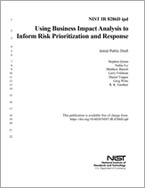 Stephen Quinn, Nahla Ivy, Matthew Barrett, Larry Feldman, Daniel Topper, Greg Witte, R. K. Gardner
Stephen Quinn, Nahla Ivy, Matthew Barrett, Larry Feldman, Daniel Topper, Greg Witte, R. K. Gardner
National Institute of Standards and Technology
Sinopse: While business impact analysis (BIA) has historically been used to determine availability requirements for business continuity, the process can be extended to provide broad understanding of the potential impacts to the enterprise mission from any type of loss. The management of enterprise risk requires a comprehensive understanding of the mission-essential functions (i.e., what must go right) and the potential risk scenarios that jeopardize those functions (i.e., what might go wrong).
The process described in this publication helps leaders determine which assets enable the achievement of mission objectives and to evaluate the factors that render assets as critical and sensitive. Based on those factors, enterprise leaders provide risk directives (i.e., risk appetite and tolerance) as input to the BIA. System owners then apply the BIA to developing asset categorization, impact values, and requirements for the protection of critical or sensitive assets.
The output of the BIA is the foundation for ERM/CSRM process, as described in the NISTIR 8286 series, and enables consistent prioritization, response, and communication regarding information security risk.
